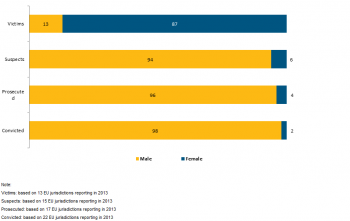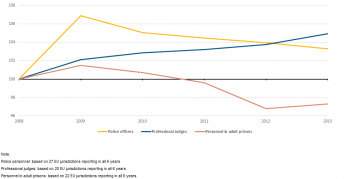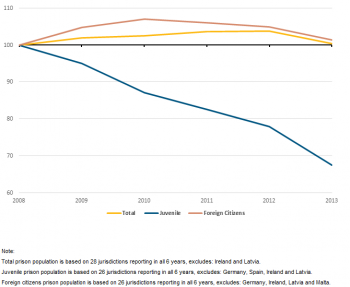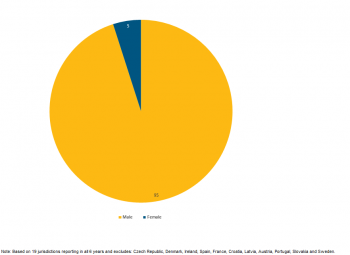Archive:Crime and criminal justice statistics, data 2008-2013
- Data extracted in Month YYYY. Most recent data: Further Eurostat information, Main tables and Database. Planned article update: (dd) Month YYYY(, hh:00).
The statistics presented in this Statistics in Focus summarise general trends in specific categories of recorded crime. The publication also looks at trends in the numbers of personnel involved in the different stages in the criminal justice system and the size of the prison population.

Source: Eurostat (crim_off_cat)

Source: Eurostat (crim_off_cat)

Source: Eurostat (crim_off_cat)

Source: Eurostat (crim_just_job)
EU trends in statistics on police-recorded crime and the criminal justice system, 2008 - 2013
The most recent Eurostat figures on crime and criminal justice statistics show that across EU Member States, the levels of police-recorded intentional homicide and assault steadily decreased between 2008 and 2013, while the number of recorded rapes increased (Figure 1).
In particular, the number of recorded offences of intentional homicide fell by 21 % between 2008 and 2013, whereas the number of recorded rapes increased by 16 % over the same period.
For sexual assault the number of recorded offences in 2013 is close to the level of 2008, although there was a decline between 2008 and 2011 followed by increases in 2012 and 2013.
Recorded burglary and drug trafficking offences display slight downward trends between 2008 and 2013 (between 3 and 5 %), while trends for robbery, kidnapping and theft were less apparent.
Overview of specific offences recorded by the police
The statistical data for the present report were collected through the first Eurostat-UNODC joint data collection on crime and criminal justice statistics and cover the period 2008-2013. This joint survey includes data on several categories of reported crime at different stages of the criminal justice system, as well as data on the number of personnel in the police, courts and prisons.
It is important to emphasise that the numbers presented in this publication do not reflect all crime across all 30 jurisdictions in the 28 Member States of the European Union (EU). Furthermore, the official recorded crime statistics exclude crimes that have not been reported to the police. The official level of recorded crime data may be influenced by different law enforcement policies and priorities in different countries. Also, the way offences are recorded will depend on the legal definitions and statistical counting rules in each jurisdiction.
It should be noted that increased counts of a particular offence may reflect greater awareness of the offence among the public, a higher number of victims reporting or changes in law enforcement policies related to that offence.
Comparing crime and criminal justice statistics from different jurisdictions is therefore difficult and can be misleading. For this reason, direct comparisons between jurisdictions have been avoided and the focus in this publication has instead been on data trends. An index has been calculated where 2008 (=100) is used as the base year. EU level figures have been calculated based on jurisdictions reporting data in all six years 2008-2013. However, results at the EU level can mask variations at the national level, and so the national figures in the detailed tables should also be taken into account.
Recorded crime for non-sexual offences
For intentional homicide, assault, robbery, kidnapping, theft, burglary and unlawful acts involving controlled drugs or precursors, the levels of recorded criminal offences across the EU in 2013 are lower than were observed in 2008 (Tables 1-7).
However, these falls do not necessarily indicate a continuous downward trend during these years for each offence, and in some cases the fall is relatively small. In addition, some individual jurisdictions show different trends to the overall EU trend.
Intentional Homicide
In this data collection intentional homicide is defined as the unlawful death purposefully inflicted on a person by another person. Data on intentional homicide also include serious assault leading to death and death as a result of a terrorist attack. Attempted homicide, manslaughter, death due to legal intervention, justifiable homicide in self-defence and death due to armed conflict are excluded.
Intentional homicide is reported fairly consistently across EU jurisdictions, with definitions varying less between countries than for other types of crime.
Police-recorded intentional homicide offences have been consistently decreasing across EU Member States from 2008 to 2013 (Figure 1). The total number of intentional homicide offences recorded across 29 EU jurisdictions in 2013 is 5 126. This is 21 % less than the number of offences recorded in 2008 (6 510) and 6 % less than in 2012 (5 476).
The number of intentional homicides recorded in individual jurisdictions is shown in Table 1.
Assault
Assault refers to physical attack against the body of another person resulting in serious bodily injury; it excludes indecent/sexual assault, threats and slapping/punching. Assault leading to death is also excluded.
Overall, the recording of assault offences also follows the decreasing trend observed in intentional homicide (Figure 1) although there are some exceptions at the national level. In comparison to 2008 there were 12 % fewer assault offences recorded in 2013 across 29 EU jurisdictions (Table 2).
Robbery
The definition used for robbery in this data collection is the theft of property from a person, overcoming resistance by force or threat of force. Where possible, muggings and theft with violence are included, whereas pick pocketing and extortion are excluded.
Recorded robbery recorded offences present a less clear trend, with fluctuations across recent years. Reported levels for robbery in 29 EU jurisdictions slightly increased in 2010 and 2011 but then decreased in 2012 and again in 2013, when there was a year-on-year fall of 6.1 % (Figure 2 and Table 3).
Kidnapping
The definition of kidnapping used in this data collection is unlawfully detaining a person or persons against their will (including through the use of force, threat, fraud or enticement) for the purpose of demanding for their liberation an illicit gain or any other economic gain or other material benefit, or in order to oblige someone to do or not to do something. Disputes over child custody are excluded from this definition.
The number of kidnapping offences, although following a decreasing trend until 2012, shows an annual increase of 5.3 % between 2012 and 2013 across the 25 jurisdictions which reported data for 2008-2013 (Figure 2 and Table 4).
Theft
Theft is defined as depriving a person or organisation of property without force with the intent to keep it. In this data collection, theft excludes burglary, housebreaking, robbery and theft of a motor vehicle.
The level of recorded theft offences remained relatively stable across 2008-2013 in the 28 jurisdictions that were able to provide data for this period (Table 5). However, the situation in individual jurisdictions is more variable, with 14 jurisdictions showing a fall over this period and 14 showing an increase.
Burglary
Burglary refers to gaining unauthorised access to a part of a building, dwelling or other premises. It includes the use of force, with the intent to steal goods (breaking and entering), theft from a house, apartment or other dwelling place, factory, shop or office, from a military establishment, or using false keys. However, it excludes theft from a car, from a container, from a vending machine, from a parking meter and from fenced meadows or compounds.
The number of recorded burglary offences among the 25 jurisdictions able to provide data for all six years (Table 6) fluctuated slightly between 2008 and 2013. Between 2012 and 2013 the number of burglary offences fell by 1.2 % (Figure 2).
Unlawful acts involving controlled drugs or precursors
In this data collection, unlawful acts involving controlled drugs or precursors include the illegal possession, cultivation, production, supplying, transportation, importing, exporting, financing, etc. of drug operations which are not solely in connection with personal use.
Overall the number of such offences recorded across EU Member States has fallen gradually since 2009, although the results for some individual jurisdictions vary between 2008 and 2013 (Table 7). In 2013 there were almost 2 % fewer offences involving controlled drugs or precursors than in 2012 (Figure 2).
Sexual violence
The number of recorded offences relating to sexual violence comprise the figures reported for rape and other sexual assault.
In this data collection, rape is defined as sexual intercourse without valid consent and sexual assault refers to sexual violence not amounting to rape. Sexual assault includes an unwanted sexual act, an attempt to obtain a sexual act, or contact or communication with unwanted sexual attention not amounting to rape. It also includes sexual assault with or without physical contact, including drug-facilitated sexual assault, sexual assault committed against a marital partner against her/his will, sexual assault against a helpless person, unwanted groping or fondling, harassment and threats of a sexual nature.
Between 2008 and 2013, the number of offences of sexual violence increased by 3.9 % in the 25 EU jurisdictions which were able to provide data for all six years. After a slight fall in 2009, the number of offences has since increased, including a rise of 6.1 % between 2012 and 2013 (Figure 2).
The number of rape offences has consistently increased since 2008, standing at 16 % higher in 2013 (Figure 3 and Table 9), based on the 28 jurisdictions which reported data. In contrast, the overall number of recorded offences for sexual assault (based on 26 jurisdictions) decreased after 2008 until a slight increase in 2012. Between 2012 and 2013 there was a further increase of just over 5 % (Figure 3 and Table 10).
Gender distribution
Figure 4 shows how the distribution between males and females varies between victims, suspects, persons prosecuted and persons convicted for offences relating to sexual violence. Most victims of sexual violence are female, whereas the suspects and offenders are mostly male.
Personnel in the criminal justice system
Personnel in the criminal justice system refer to police, courts and prison personnel. Police personnel are defined as employees of public agencies on 31 December, whose principal functions are the prevention, detection and investigation of crime and apprehension of alleged offenders. The definition excludes support staff such as secretaries and clerks.
Professional judges are defined as both full-time and part-time official legal professionals on 31 December, who have been recruited and are paid to practise as a judge. They are authorised to hear civil, criminal and other cases, including cases in appeal courts, and to make dispositions in a court of law. Non-professional judges such as lay judges and lay magistrates are excluded.
“Prison personnel” refers to individuals employed in penal or correctional institutions on 31 December. The numbers include management, treatment, custodial and other personnel, such as those involved in prison maintenance or the provision of prison food.
Figure 5 shows recent trends in the number of personnel at different stages of the criminal justice system (police, court and prison) for the EU jurisdictions that provided data.
For police personnel, the overall numbers gradually decreased after 2009 in the 27 jurisdictions reporting data for 2008-2013. The increase of 7 % between 2008 and 2009 is due in part to changes to the way certain categories of police officers have been counted in some jurisdictions from 2009.
Further changes in the way national police personnel are counted took place in 2010 and 2013 (see Table 11).
The figures reported in 22 jurisdictions for prison personnel in adult prisons are 3 % lower in 2013 than the level in 2008, although there were small annual increases in 2009 and 2013 (Table 17).
In contrast, in the 20 jurisdictions providing the numbers of professional judges, there has been a steady increase in the overall figures reported in each year. Between 2008 and 2013, the number of professional judges has increased by 5 % (Table 14).
Gender distribution
Not all Member States are able to provide disaggregation of the total numbers in terms of gender, but where figures are available, it is the police and prison services where women are particularly under-represented (Figure 6).
In 2013, 80 % of the police personnel were male compared with 20 % who were female. In 2008 the proportion of police personnel who were female was 17 % (Tables 12 and 13).
For prison services, the proportion of female staff in adult prisons has remained at 25 % between 2008 and 2013 (Tables 17 and 18).
In contrast, the proportion of professional judges who are female was 61 % in 2013, slightly higher than the figure of 60 % in 2008 (Tables 15 and 16).0
Prison population
The data collected on prisons refers to all institutions under the authority of the prison administration where persons are deprived of their liberty. Centres for the detention of foreign citizens held pending an investigation into their immigration status, or for the detention of foreign citizens without a legal right to stay, are excluded.
In 2013 the total number of prisoners in the EU was close to the level in 2008, although there had been increases in the intervening years 2009-2012. A similar pattern occurred for the number of prisoners with foreign citizenship, which rose in 2009 and 2010 before declining from 2011 (Figure 7).
Regarding juvenile prisoners there is a different trend over the six year period. The number of juvenile prisoners across the EU has steadily decreased since 2008 and in 2013 the number was 33 % below the level in 2008 (see also Table 23).
Gender distribution
The proportion of adult male and adult female prisoners across the 19 EU jurisdictions able to report figures has remained relatively stable between 2008 and 2013. Overall, adult male prisoners account for 95 % of the prison population (Figure 8).
Detailed tables
Data sources and availability
The statistical data for the present report were collected through the first Eurostat-UNODC joint data collection on crime and criminal justice statistics using the Survey on Crime Trends developed by the United Nations Office on Drugs and Crime ([1]).
Countries were asked to adhere to standard definitions when assembling the figures and to provide details of any divergences.
Figures for the United Kingdom are reported separately (as UK: England & Wales, UK: Scotland and UK: Northern Ireland) owing to the existence of three separate jurisdictions.
The data are taken from administrative records. Direct comparisons of crime levels based on the absolute figures can be misleading as they are affected by many factors, including:
- different legal and criminal justice systems
- rates at which crimes are reported and recorded
- differences in the point at which crime is measured (for example, when reported to the police, on identification of suspects, etc.)
- differences in the rules by which multiple offences are counted
- differences in the list of offences that are included in the overall crime figures
Figures for the prison population may also be affected by many factors, including:
- number of cases dealt with by the courts
- the percentage receiving a custodial sentence
- the length of the sentences imposed
- the size of the population on remand
- the date of the survey, especially where amnesties apply
For these reasons, direct comparisons of crime levels in different countries will be misleading. More detailed information about the data at a national level are available in the reference metadata files which accompany the data in the Eurostat database.
Care should be taken when considering low numbers. For example homicide rates may vary considerably between years, especially in small countries.
In general comparisons are best made on trends rather than levels, on the assumption that the characteristics of the recording system within a country remain fairly constant over time. However, there are many exceptions as methods change over time and this causes breaks in the series. In order to identify the trends, indices have been calculated for all national series data using the 2008 figure as a base:
- Index Ii = index number for year i = (Ci/Cbase) * 100
- Ci = number recorded for year i
- Cbase = number recorded in the base year 2008.
Context
The progressive elimination of border controls within the EU has considerably facilitated the free movement of European citizens, but may have also made it easier for criminals to operate, especially since the scope of law enforcement authorities and criminal justice systems is generally limited to the boundaries of national borders.
Since the adoption of the Amsterdam Treaty, the EU has set itself the objective of providing a common area of freedom, security and justice. This goal was further developed by the Hague programme in 2004, which outlined ten priority areas: strengthening fundamental rights and citizenship; anti-terrorist measures; defining a balanced approach to migration; developing integrated management of the EU’s external borders; setting-up a common asylum procedure; maximising the positive impact of immigration; striking the right balance between privacy and security while sharing information; developing a strategic concept on tackling organised crime; ensuring a genuine European area of justice; and sharing responsibility and solidarity.
As part of the work to harmonise and develop statistics on crime and criminal justice systems, EU Member States agreed to approximate the definitions of offences and the level of sanctions for certain type of offences. Furthermore, mutual recognition of decisions taken by national judges is set to become the cornerstone of judicial cooperation in criminal matters, with a range of tools having been developed to facilitate practical cooperation across borders.
With respect to police cooperation, the EU seeks to grant law enforcement authorities in each of the Member States access to relevant information (such as DNA, fingerprint, vehicle registration or immigration databases), and to improve police cooperation within a common framework for the protection of personal data. Access to information is covered by a raft of legislation, including the Data Retention Directive 2006/24/EC, the Swedish Initiative Framework Decision 2006/960/JHA, the Prüm Council Decision 2008/615/JHA, and the Regulation 767/2008 concerning a visa information system (VIS) and the exchange of data between Member States.
Police cooperation has been encouraged through legislation such as Framework Decision 2002/465/JHA on Joint Investigation Teams and Council Decision 2008/617/JHA on improved cooperation between special intervention units, while a range of organisations/bodies have been created to aid cooperation between different law enforcement agencies, such as the European Police College (CEPOL), the European Police Office (Europol) or the European agency for the management of operational cooperation at the external borders of the Member States of the EU (Frontex). Furthermore, the EU supports a range of national and multi-national projects, through programmes such as the ‘Prevention of and fight against crime’ (Council Decision 2007/125/JHA).
See also
Further Eurostat information
Publications
- Trends in crime and criminal justice, 2010 — Statistics in focus 18/2013
- Trafficking in human beings — 2013 edition — Working Paper
- Money Laundering in Europe — 2013 edition — Working Paper
Database
- Recorded offences by offence category (source: police data) (crim_off_cat)
- Intentional homicide and sexual offences by legal status and sex of the person involved – number and rate for the relevant sex group (crim_hom_soff)
- Intentional homicide victims by victim-offender relationship and sex - number and rate for the relevant sex group (crim_hom_vrel)
- Intentional homicide victims by age and sex - number and rate for the relevant sex and age groups (crim_hom_vage)
- Intentional homicide victims in largest cities by sex (crim_hom_vcit)
- Intentional homicide offences in largest cities (crim_hom_ocit)
- Suspects and offenders by sex - number and rate for the relevant sex group (crim_just_sex)
- Suspects and offenders by age - number and rate for the relevant age group (crim_just_age)
- Suspects and offenders by citizenship (crim_just_ctz)
- Personnel in the criminal justice system by sex - number and rate for the relevant sex group (crim_just_job)
- Legal cases processed in first instance courts by legal status of the court process (crim_crt_case)
- Persons brought before criminal courts by legal status of the court process (crim_crt_per)
- Prisoners by offence category and sex - number and rate for the relevant sex group (crim_pris_off)
- Prison capacity and number of persons held (crim_pris_cap)
- Prisoners by age and sex - number and rate for the relevant sex and age groups (crim_pris_age)
- Prisoners by citizenship (crim_pris_ctz)
- Prisoners by legal status of the trial process (crim_pris_tri)
- Crimes recorded by the police by by offence category (crim_gen)
- Crimes recorded by the police by NUTS 3 regions (crim_gen_reg)
- Crimes recorded by the police: homicide in cities (crim_hom_city)
- Crimes recorded by the police (1950-2000) (crim_hist)
- Police officers (crim_plce)
- Prison population (crim_pris)
Dedicated section
Methodology / Metadata
- Crime and criminal justice (ESMS metadata file — crim_esms)
Source data for tables, figures and maps (MS Excel)
Other information
- Commission Communication COM/2006/437 final: Developing a comprehensive and coherent EU strategy to measure crime and criminal justice: an EU Action Plan 2006–2010
- The Hague Programme: strengthening freedom, security and justice in the European Union (Official Journal C 53 of 3.3.2005, p.11)
- The Stockholm Programme — An open and secure Europe serving and protecting citizens (Official Journal C 115 of 4.5.2010, p.1)
External links
- Council of Europe
- European Institute for Gender Equality
- European Monitoring Centre for Drugs and Drug Addiction
- European Sourcebook of Crime and Criminal Justice Statistics — 4th edition
- European Union Agency for Fundamental Rights
- United Nations Office on Drugs and Crime — Data and analysis
Notes
- ↑ United Nations Office on Drugs and Crime http://www.unodc.org/unodc/en/data-and-analysis/index.html



